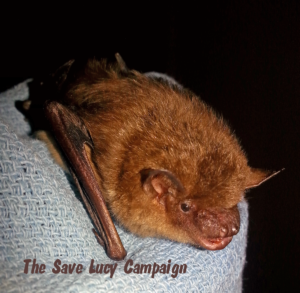
Hi everyone! I hope you all had a good week. Save Lucy’s President, Mrs. Sturges, found an interesting article that looks into the mystery of bat sounds. Scientists have found that some of the sounds that bats make resemble those of birds. Out of the 1,300 different bat species, the social vocalizations of about 50 have been studied. Of those 50, scientists discovered that about 20 of them are actually singing. It’s hard to hear bats singing if you go outside and watch them flying around. This is because a bat’s vocal range is in the ultrasonic range that is inaudible to human ears. In order to hear the bats’ sounds and research them further, scientists recorded bats singing and slowed them down. Their research has shown some similarities between bat and bird songs. Both bats and birds use the basal ganglia and prefrontal cortex parts of their brains to sing. Scientists believe that neural circuits also control bat vocals and how they are able to sing. Even though most bat species sing in an ultrasonic range, one species loves to sing in a range that humans can hear. The singing of the Greater Sac-Winged bat can be heard for miles. If you would like to read more about bats singing, you can find the article here. And now for a public service announcement. Daylight Savings Time begins on Sunday. Don’t forget to move your clocks 1 hour ahead before you go to bed tonight.
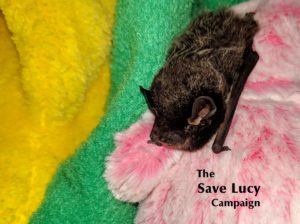
Hi everyone! I hope you all had a good week. I had a fabulous one because it was a holiday week and it snowed! Snow days are always especially fun! It’s been an exciting week at the Save Lucy Campaign. That’s because there is a cute new rescue. An adorable little Silver Haired bat was rescued a few days ago by the people working at the Hidden Oaks Nature Center in Annandale, VA. The bat is now being cared for by Save Lucy rehabilitators. The bat’s primary caretakers at Save Lucy have generously named him # 2019-19. Bats in rehabilitation are usually given numbers for names. However, seeing as no one wants their name to be a number, I think he needs a better name. Something sophisticated and grand. A name like Sherman! Since our newest addition is a Silver Haired bat, I thought I would write a little bit about them. They have beautiful black or, less commonly, dark brown fur. The hair on their back has lovely silver tips. These bats live throughout the United States and into Canada and Mexico. They haven’t been found anywhere above southeast Alaska though. One interesting fact about the Silver Haired bats is that they are one of the slowest flying bats in North America. If you would like to read more about silver haired bats in Alaska, you can do so here. I hope everyone has a fantastic week!

Hi everyone! I hope you all had a good week! I have been very busy with school and I’m looking forward to my three-day weekend. Recently, Franklin Junior High in St. Mary Parish in Louisiana has become a home to some fuzzy creatures. This is after Zachary High, the University of Louisiana at Monroe, and Gueydan High in Vermilion Parish became home to colonies of migrating Mexican free-tailed bats. A United Bat Control Owner went to Franklin Junior High to have a look. She says that it is most likely that the bats wanted to keep warm as they migrate north from Mexico to their spring homes. The bats decided to take up residency in the school’s gym. To protect the bats and the students, school was closed on the 14th and the 15th. School officials might have to close the school on Monday too, if they can’t get the bats out. Right now, their plan is to close all of the school’s doors and windows while the bats are all out hunting for tasty bugs. Then, before the bats come in again, they will seal up any openings to make sure the bats stay out in the wild where they belong. If you would like to read more, you can do so here.
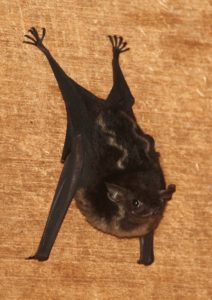
Hi everyone! I hope you all had a good week! Yesterday, a dam at an iron-ore mine in Brazil collapsed. Because of this disaster, I thought I would research a bat from Brazil. I found a very cute bat! It looks like a shrew that knows something you don’t. It’s called the Greater sac-winged bat. In addition to Brazil, these bats live in several other Central and South American countries. Their range is from central Mexico, through Central America, into South America. They live in the South American countries of Brazil, Bolivia, Guyana, Suriname, Guyane, and the Antillean islands. The Greater sac-winged bat has dark brown fur, and some have zig-zag stripes on their back. They have long noses and upper lips that are very mobile. They get their name from the small sacs or pouches on their wings. While grooming themselves, the males fill their sacs with drops of urine and glandular secretions. When they are trying to attract a female, the male will hover over her and flap the scent in their sacs toward her. They will also use this technique to ward off other bats from outside their territory. Another interesting fact about these bats is that their pups babble. They will vocalize calls and other sounds, but jumbled up just like a human baby’s babbles. This is the first mammal that is not a primate to be seen babbling. If you’d like to read more about the Greater sac-winged bat, you can find information here.
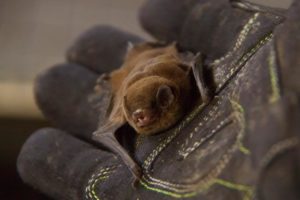
Hello everyone! I hope you all had a good week. I had a pretty good one because it started with a snow day. That’s right, it finally snowed! While it has been cold and wintery here in the US, people in Australia are in the middle of summer. And with Australian summers, come fires. Because there are so many fires burning in Australia right now, I decided to research an Australian bat. There is a cute little bat called the Chocolate Wattled Bat. Unlike most bats living in Australia, these bats are micro-bats! They have milk-chocolate brown fur, which is where they get their name. They also have a pink nose and a cute, squishy face. They like to roost under bark and in tree hollows in south-western Australia. Their diet consists of moths and beetles. And the Chocolate Wattled Bat will hibernate in the winter when the insects aren’t always around. Although south-western Australia isn’t known for being cold, it does get chilly. And with food scarce, they can’t eat enough to keep them warm. These bats do have a few predators including hawks, owls, cats, wildfires, and humans. If you would like to read more about the Chocolate Wattled Bat, you can find information here and here.
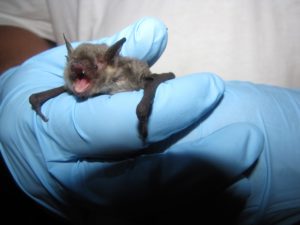
Hi everyone! I hope you all had a good week. It hasn’t been a very good week for National Parks and the plants and animals that live in them. That’s because the government shutdown continues. Many parks around the country are closed, but some remain open. Many of the parks that are open are suffering because of the lack of employees working at the park. Parks are being vandalized and trash is piling up. Sadly, vandals have even killed trees at Joshua Tree National Park. There are other effects of the shutdown too. Because government employees are not allowed to report to work, wildlife conservation and research has been put on hold. That means that government research on White-Nose Syndrome in bats has been halted. Luckily, not all government work has stopped. The US Fish and Wildlife Service has halted construction on 16 miles of Oklahoma Highway 16 between the town of Okay and the city of Wagoner. The work has been stopped to give investigators time to determine whether the construction will affect endangered Gray Bats in the area. Research is needed to determine whether or not sediment from the road construction has been affecting the quality of the water in the area. This could reduce the number of insects in the area, which would affect the bat’s ability to find food. If you would like to read more about this, you can find information here. I hope everyone has a good week. And, please, if you are fortunate enough to be allowed onto National Park land during this shutdown, take care of our parks. Please pick up your trash, stay on trails, and respect the plants and animals who live there.
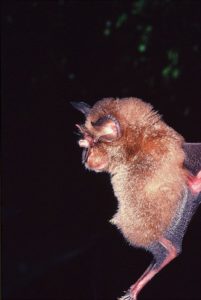
We want to thank Blogger Rachael on her 51st blog post this year! She’s featured almost 30 species. Thank you Rachael. We’re looking forward to what you discover in 2019! Hi everyone! I hope you all had a very Merry Christmas and are enjoying your winter holidays. I am enjoying my school vacation very much. Since this is my last blog post of the year, I thought it would be nice to look back at all that happened this year. It’s been a rather long year that began with the Winter Olympics in Pyeong Chang, South Korea and is ending with a tsunami and volcanic eruptions in Indonesia. In between, there were hurricanes, wild fires, earthquakes, and more volcanic eruptions. It sounds like a bad year, but there were also some good things that happened. Over the summer, 12 members of a youth soccer team and their coach were rescued from an underground cave in Thailand. Not only did we have the Winter Olympics this year, but we also came together for the World Cup in July. And, in what is possibly the cutest news story of the year, an adult male koala needed to be rescued for the third time in his life when he got his head stuck in a fence in South Australia. And now, since the people of Indonesia are having such a difficult time, I thought I’d research another Indonesian bat. I found an adorable leaf nosed bat called the Arcuate horseshoe bat. They were discovered by Wilhelm Peters in 1871. He gave them the name “arcuatus” which is Latin for “curved”. Peters never said why he decided to name these bats curved, but some scientists believe that it is due to the curve of their nose. These adorable furry critters live in Southeast Asia, […]
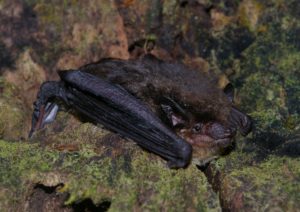
Hi everyone! I hope you all had a good week! I’m excited because it’s almost Christmas! I found a very interesting article about a group of scientists in Uruguay who are creating a special AI algorithm that will help in identifying bats flying around! This is important because bats in South America speak different dialects than the same species in North America. So, the databases in use in North America don’t work in Uruguay or the rest of South America. This new algorithm will be able to pick up a bat’s call through a microphone and determine which species it is. This algorithm was first created to help scientists learn which bats were flying into windmills. This information could then be used to work with wind farm operators to help protect bats. Studies have shown that more than 40 bat species are affected by windmills and almost 300 mass bat death events have occurred due to wind turbine blades. Until now, scientists needed to catch bats flying in an area in order to identify them. With this algorithm, the very difficult and time-consuming task of catching a bat is no longer necessary. In addition to being used to help scientists protect bats from wind turbines, this algorithm could be used to identify unknown bat species. Hopefully the use of this algorithm will help scientists locate a bat that has been believed extinct in Uruguay for 50 years. If you would like to read more about this study, you can find information here. .
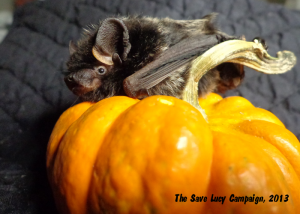
Hi everyone! I hope you all had a good week. My week started with my dog’s birthday. We’ve been celebrating and spoiling her all week. Yesterday, there was an earthquake in Alaska. I decided to research an Alaskan bat. I found an adorable bat called the Silver-haired bat. The Silver-haired bat lives in the temperate rain forests of Southeast Alaska. Actually, these bats live throughout the United States, including Save Lucy’s state of Virginia, and southern Canada. The Silver-haired bat has black fur all over its body except for their ears. The black fur on their back has silver tips which makes the bat look like it has a back full of silver fur. These bats also have short round and hairless ears that lay close to their head. Like all bats in North America, these bats are insectivores. They love to munch on an assortment of meals such as flies, moths, mosquitoes, beetles, ants, and crickets. Silver-haired bats like to roost near water in areas near lakes, ponds, and streams. They roost here because they hunt close to the water where there is an abundance of tasty bugs for them to crunch on. They roost in tree foliage, under loose bark, and sometimes buildings. They like to hibernate under loose bark and in tree hollows. If you would like to learn more about the Silver-haired bat, you can read about them here and here.
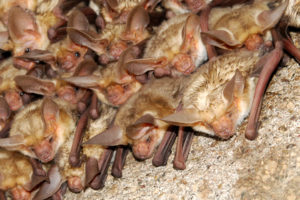
Hi everyone! I hope you all had a good week! People in California have been having a hard time. They are having some really bad wildfires again. This week’s blog is dedicated to all the people in California affected by these fires. I found a handsome bat that lives in California called the Pallid Bat. I think I have written about this bat before, but it is so cute that I thought it would be nice to read about them again. This bat also lives in British Columbia all the way down to central Mexico. They also live as far east as western Texas, Oklahoma, and southern Kansas. The Pallid Bat is found in deserts, rocky places, oak and pine forests, and farmland. These bats like to roost in caves, rock crevices, mines, hollow trees, and buildings. These adorable bats have light brown fur with pale white fur on their stomachs. They have special glands on their face, much like the glands of skunks. The glands produce an odor just like a skunk’s too. They use this odor to defend themselves. The Pallid Bat has an amazing adaptation. Unlike most bats, the Pallid Bat does not eat their food while flying. They land and then eat! They swoop down on their pray, and then carry their meal to a safe perch where they can eat it. These bats feast on crickets, beetles, grasshoppers, and scorpions. Most North American bats aren’t big enough to safely take down a scorpion, but these fluff balls are actually immune to a scorpion’s sting. [And they pollinate cactus! Researchers noted that pallid bats netted near columnar cactus were often covered in pollen, but it was assumed they were picking up pollen while gleaning for insects. Researchers studying the plant interactions of another bat, the nectar […]









